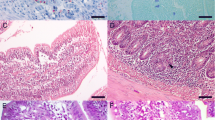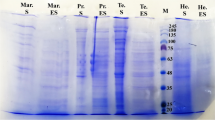Abstract
An experimental infection of rabbits with a wild isolate of the gastric nematode Graphidium strigosum was carried out. Animals (3.5 months age) were infected with 1,000 L3 administered by bucoesophagic catheter (five rabbits) or kept as uninfected control group (five animals). The infection was maintained for 3 months. Along the experimental period, some parasitological, hematological and immunological parameters were determined. Prepatent period of the infection ranged from 30 to 38 days and, at necropsy, average adult helminth counts were 430.75 ± 126.12. No significant variations were found in packed cell volume, leukocyte, and eosinophil counts along the experimental period. Infection elicited a clear serum-specific IgG response, estimated by ELISA, during patency. Pooled sera from the patent period of the infection recognized some soluble antigens, particularly, a 67-kDa protein. Experimentally infected animals did not show cross recognition between G. strigosum, Haemonchus contortus, and Teladorsagia circumcincta. However, Western blot analysis with hyperimmune sera against H. contortus raised in rabbits and lambs showed cross reactivity between this helminth species and G. strigosum.






Similar content being viewed by others
References
Alunda JM, Angulo-Cubillán F, Cuquerella M (2003) Immunization against ovine haemonchosis with three low molecular weight somatic antigens of adult Haemonchus contortus. J Vet Med B 50:70–74
Audebert F, Durette-Desset MC (2007) Do lagomorphs play a relay role in the evolution of the Trichostrongylina nematodes. Parasite 14:183–197
Aumont G, Gruner L, Hostache G (2003) Comparison of the resistance to sympatric and allopatric isolates of Haemonchus contortus of black belly sheep in Guadeloupe (FW) and of INRA 401 sheep in France. Vet Parasitol 116:139–150
Bowman DD, Lynn RC, Eberhard ML (2004) Georgi’s Parasitología para veterinarios. Trad. esp. 8a edición. Elsevier, Madrid
Cabaret J (1981) Egg output of Graphidium strigosum (Nematoda) in low-level prime infection of rabbits. Folia Parasitologica 28:337–341
Conder GA, Jonson SS, May AD, Fleming MW, Millis MD, Guimond PM (1992) Growth and development of Haemonchus contortus in jirds, Meriones unguiculatus. J Parasitol 76:492–497
Cuquerella M, Gómez-Muñoz MT, Carrera L, de la Fuente C, Alunda JM (1994) Cross antigenicity among ovine trichostrongyloidea. Preliminary report. Vet Parasitol 53:243–251
Domínguez-Toraño IA, Cuquerella M, Gómez-Muñoz MT, Méndez S, Fernández-Pérez FJ, Alunda JM (2000) Vaccination of Manchego lambs against Haemonchus contortus with a somatic fraction (p26/23) of adult parasites. Parasite Immunol 22:131–138
Durette-Desset MC, Hugot JP, Darlu P, Chabaud AG (1999) A cladistic analysis of the Trichostrongyloidea (Nematoda). Int J Parasitol 29:1065–1086
Enigk K (1938) Ein Beitrag fur Physiologie und zum Wirt-Parasit-Verhaltnis von Graphidium strigosum (Trichostrongylidae, Nematoda). Zeitscrift fur Parasitenkunde 10:386–414
Gómez-Muñoz MT, Cuquerella M, Gómez-Iglesias LA, Méndez S, Fernández-Pérez FJ, de la Fuente C, Alunda JM (1999) Serum antibody response of Castellana sheep to Haemonchus contortus infection and challenge: relationship to abomasal worm burdens. Vet Parasitol 81:281–293
Hadebert F, Cassone J, Kerboeuf D, Durette-Desset MC (2002) The life cycle of Nematodiroides zembrae (Nematoda, Trichostrongylina) in the rabbit. J Parasitol 88:898–904
Klesius PH, Washburn SM, Ciordia H, Haynes TB, Snider TG (1984) Lymphocyte reactivity to Ostertagia ostertagi L3 antigen in type I ostertagiasis. Am J Vet Res 45:230–233
Knox DP, Smith SK, Smith WD (1999) Immunization with an affinity purified protein extract from the adult parasite protects lambs against infection with Haemonchus contortus. Parasite Immunol 21:201–210
Königová A, Hrčkova G, Velebný S, Čorba J, Várady M (2008) Experimental infections of Haemonchus contortus strains resistant and susceptible to benzimidazoles and the effect on mast cells distribution in the stomach of Mongolian gerbils (Meriones unguiculatus). Parasitol Res 102:587–595
Kooyman FM, Schallig HD, Van Leeuwen MA, Mackellar A, Huntley JF, Cornelissen AW, Vervelde L (2000) Protection in lambs vaccinated with Haemonchus contortus antigens is age related, and correlates with IgE rather than IgG1 antibody. Parasite Immunol 22:13–20
Krecek RC, Waller PJ (2006) Towards the implementation of the “basket of options” approach to helminth parasite control of livestock: emphasis on the tropics/subtropics. Vet Parasitol 139:270–282
Lello J, Boag B, Fenton A, Stevenson IR, Hudson PJ (2004) Competition and mutualism among the gut helminths of a mammalian host. Nature 428:840–844
Massone A, Capucci L, Macchi C, Giovannini S, Lavazza A (2003) Controllo sanitario di coniglio selvatici nel Parco del Serio (Provincia di Bergamo). J Mt Ecol 7(Suppl.):155–164
Ministry of Agriculture, Fisheries and Food (MAFF) (1971) Manual of Veterinary Parasitological laboratory techniques. HMSO London
Newton SE, Meeusen ENT (2003) Progress and new technologies for developing vaccines against gastrointestinal nematode parasites of sheep. Parasite Immunol 25:283–296
Nickel EA, Haupt W (1986) Experimental studies on the course and consequences of infection with Graphidium strigosum (Nematoda, Trichostrongylidae) in Oryctolagus cuniculus (domestic rabbit). Angewandte Parasitologie 27:215–219
Vercruysse J, Schetters TPM, Knox DP, Willadsen P, Claerebout E (2007) Control of parasitic disease using vaccines: an answer to drug resistance. Rev Sci Tech Off Int Epiz 26:105–111
Wibbelt G, Frölich K (2005) Infectious diseases in European hare (Lepus europaeus). Wild Biol Pract June 1:89–93
Wolstenholme AJ, Fairweather I, Prochard R, von Samson-Himmelstjerna G, Sangster NC (2004) Drug resistance in veterinary helminths. Trends in Parasitology 20:469–476
Acknowledgements
Research was funded by CICYT project AGL2006-10589. Support from the UCM Special Action to JMA (AE3/08-16119) is acknowledged. Valuable comments by Dr. S. Méndez (J.A. Baker Institute, Cornell University) and an anonymous reviewer improved the manuscript. R. Paramio provided excellent technical assistance.
Experimental conditions comply with the Spanish laws on animal experimentation.
Author information
Authors and Affiliations
Corresponding author
Rights and permissions
About this article
Cite this article
Cuquerella, M., Alunda, J.M. Immunobiological characterization of Graphidium strigosum experimental infection in rabbits (Oryctolagus cuniculus). Parasitol Res 104, 371–376 (2009). https://doi.org/10.1007/s00436-008-1206-y
Received:
Accepted:
Published:
Issue Date:
DOI: https://doi.org/10.1007/s00436-008-1206-y




